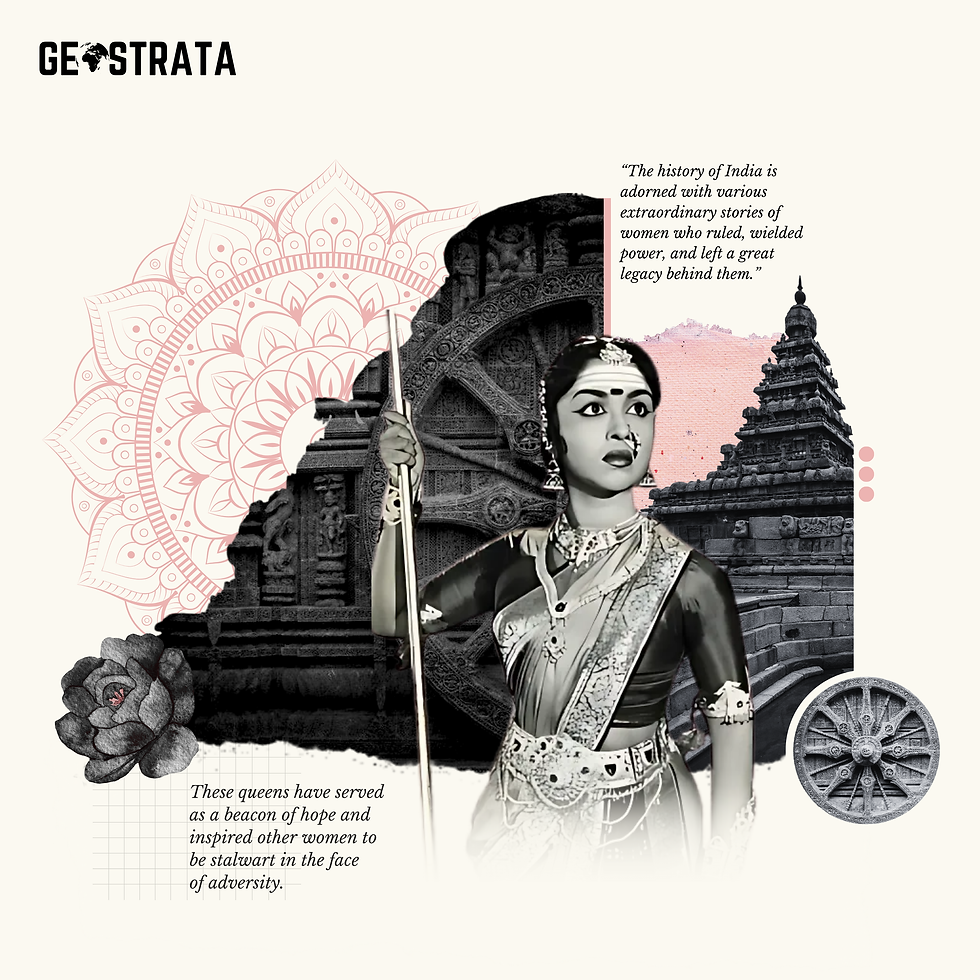Representation of Women in the 18th Lok Sabha
- THE GEOSTRATA

- Mar 31
- 4 min read
Updated: Apr 1
The completion of the 18th Lok Sabha Elections and the emergence of the BJP as the single largest party, forming the government in an alliance with the NDA and other parties, resulted in a third consecutive term for PM Narendra Modi.
Illustration by The Geostrata
The 2024 elections left a significant impact all over the nation, be it the stakeholders, parties and citizens and on the other countries as well. We saw the Indian Stock Market tremble during the exit polls, indicating a panic from the investors abroad. While this situation was back to normal after the election results were announced, there was another major blow waiting for the Indian citizens.
For the past 10 years, we had a stable government, dominating in numbers and having the trust of the citizens. After the results, the government that was formed was not from a single largest party, but from a party-led alliance.
The 180-degree shift in the central government’s stakeholdership was something neither the parties nor the citizens were expecting, as per the exit polls. However, this drift highlighted the citizens’ trust issues and discontentment with the government and its policies.
THE SUBJECT MATTER
The general elections were held after the Parliament cleared the Women’s Reservation Bill in September 2023. Still, these elections resulted in the appointment of merely 74 female MPs along with 469 men MPs, directing a decrease in the percentage of women representatives in the Lok Sabha.
This bill defined a 33% reservation for women candidates in the next 15 years in both Parliament and the Legislative Assembly, along with a mandated reservation for ST & SC individuals within the women's reservation. Representation of Women in the 18th Lok The act awaits implementation, but the participation and selection of women candidates declined despite the issue of women's representation being taken up.
The bill, also called “Nari Shakti Vandan Adhiniyam”, will only come into existence after a delimitation exercise, which will be in 2026. Even after that, we will get to see its implications only in the 2029 general elections.
The decrease in the women’s share in the Parliament from 14.4 % in 2019 to 13.6% in 2024 is certainly minimal but sheds a negative light on India’s image in representing women in the political arena. This translates to only 74 women MPs out of 543 MPs in total, with 2 cabinet ministers and five state ministers in the newly elected council of ministers.
THE BRIGHT SIDE
Women ministers elected in the 2024 general elections :
Nirmala Sitharaman: Minister of Finance, Minister of Corporate Affairs
Annapurna Devi: Minister of Women and Child Development
Shobha Karandlaje: Minister of State in the Ministry of MSMEs, Minister of State in the Ministry of Labour & Employment
Raksha Nikhil Khadse: Minister of State in the Ministry of Youth Affairs & Sports
Savitri Thakur: Minister of State in the Ministry of Women & Child Development
Anupriya Patel: Minister of State for Health and Family Welfare
Nimuben Jayantibhai Bhambhaniya: Minister of State in the Ministry of Consumer Affairs, Food and Public Distribution
Holding the Finance ministry for the second consecutive time, Nirmala Sitharaman has been the Defence Minister from 2017-2019 and a State Minister in the Finance Ministry and Corporate Affairs Ministry before 2017, which shows her diverse experience of two crucial ministry portfolios.
Shobha Karandjale and Raksha Khadse, both hailing from BJP, have been serving the Lok Sabha seat since 2014. Nimuben Jayantibhai Bambhaniya and Savitri Thakur, also hailing from the BJP, were elected for the first time as State Ministers.
Annapurna Devi served as a member of Jharkhand's Legislative Assembly and Minister of State for Education previously. Anupriya Patel served as a member of Uttar Pradesh’s Legislative Assembly and Minister of State for Commerce & Industry as well as the Ministry of Health and Family Welfare.
THE ISSUES WITHIN
A major share of women MPs comes from Chhattisgarh with 27%, followed by 25% in West Bengal and Himachal Pradesh and 20% in Uttarakhand and Madhya Pradesh. Tamil Nadu, with 12.8%, and Uttar Pradesh accounted for 8.75% of the share in women's representation, while other states were even lower.
Odisha, which had 33% women’s share in the 17th Lok Sabha, now declined to 19%. Other states like Maharashtra, Punjab, Assam and Gujarat lowered their women MPs ratio.
The underrepresentation of women in the Parliament can be hypothesized through two situations: either the tickets were not preferred for the female candidature or there might be a fewer number of women interested in political affairs.
Out of all the candidates who contested elections, women candidates were less than 10%; just 800 women out of 8360 candidates. Even if the women contesting elections has increased from just 2.9% in 1957 to a mere 10% in 2024, the representation in public advocacy and serving is somewhat inadequate.
Image Credits: Rightful Owner
Compared to other nations, we are lagging in terms of equitable gender representation in Parliament. While we are standing at 13.6%, South Africa leads with 46%, followed by the UK with 35% and the US with 29% of women’s share in their respective Parliaments.
The right for women to serve the citizens of the country by advocating their side, bringing out effective policies, ensuring equal participation and being resourceful contributors to the government should be a given across all political hierarchies.
Effective and proactive measures should be taken to bring gender parity to the political landscape, leading to inclusivity and equality. Some doable and scalable measures include training & leadership programmes, mentoring local women leaders and in-office assistants of an MP or MLA and financial aid by the state or the center for parties having maximum women representatives.
More feasibly, pushing the grassroots-level female leaders to new heights and encouraging women to pursue politics as a career through civic participation can change the status quo gradually.
The transition from a developing nation to a developed nation requires citizens to participate in the growth process, which entails equal opportunities for men, women and others. Undervaluing the potential of a significant population in a particular domain can lead to an imbalance which can hamper the development of a nation.
By providing voting rights to women, we ensured their equal participation in democracy and upheld their opinions. Now, by providing women a chance to formulate and advocate the collective rights of the citizens, we will ensure their equal involvement in sustaining the democracy.
If we can have ‘Women in Tech’ ,’ Women in STEM’ and ‘Women in Econ’, then we can also have ‘Women in Politics'!
BY MEHAK LATWAL
TEAM GEOSTRATA
.png)









This is a great piece that highlights how there is a greater role played by women in postions of power, and India is truly prepared to face new challenges.